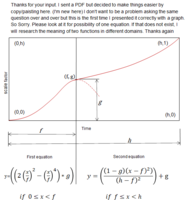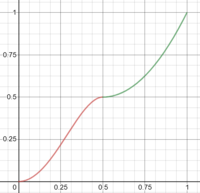Thank you in advance
?=[2∗(?/?)^2−(?/?)^4]∗? from 0 to f
y=[((1−?)(?−?)^2))/(ℎ−?))^2]+? from f to h
The first equation is an s-curve that starts at (0,0) and goes to (f,g) The second curve starts the same point (f,g) and goes to (h,1), therefore, this is a scale factor equation. How do you combine these two equations into a single equation that goes from (0,0) to (h,1). Please show the steps.
I have tried to differentiate each equation. Add those together and then integrate over the given limits. It does not work. Please help.
Once again, I apreciate your efforts.
?=[2∗(?/?)^2−(?/?)^4]∗? from 0 to f
y=[((1−?)(?−?)^2))/(ℎ−?))^2]+? from f to h
The first equation is an s-curve that starts at (0,0) and goes to (f,g) The second curve starts the same point (f,g) and goes to (h,1), therefore, this is a scale factor equation. How do you combine these two equations into a single equation that goes from (0,0) to (h,1). Please show the steps.
I have tried to differentiate each equation. Add those together and then integrate over the given limits. It does not work. Please help.
Once again, I apreciate your efforts.


